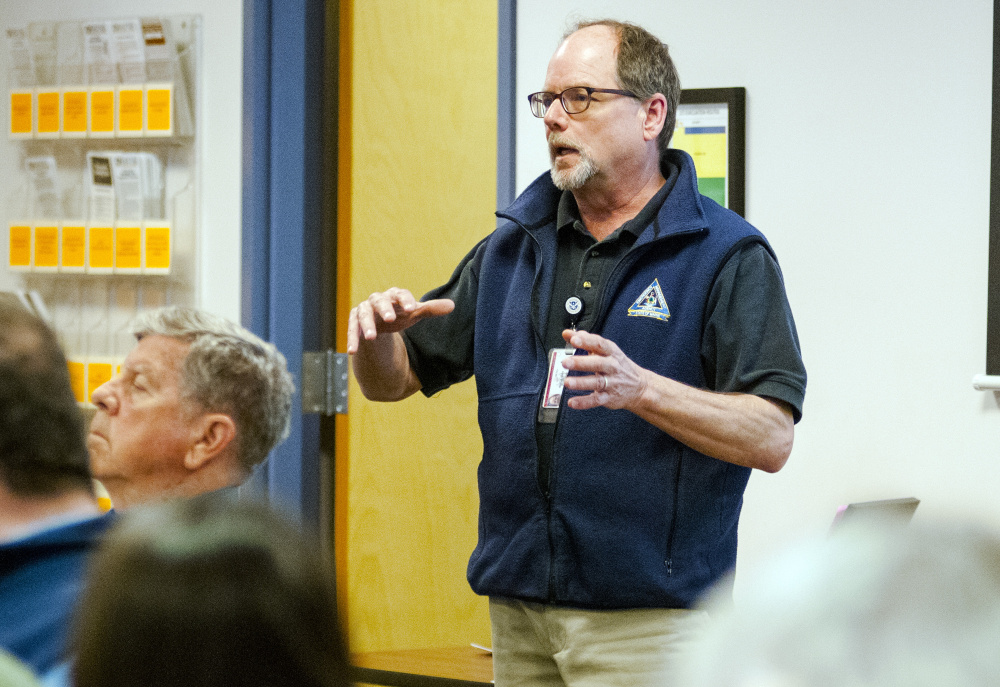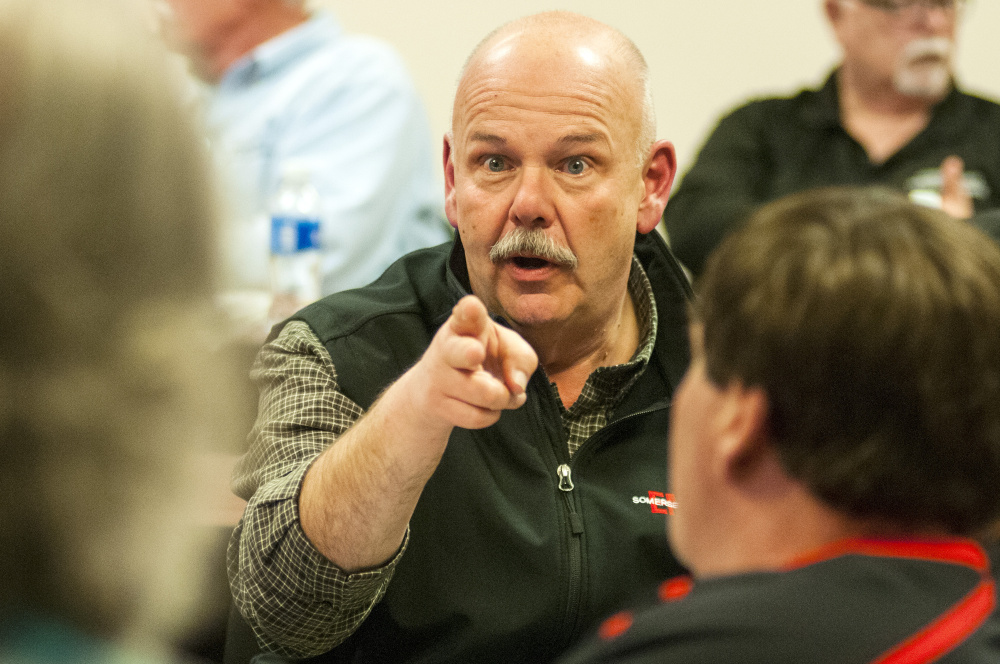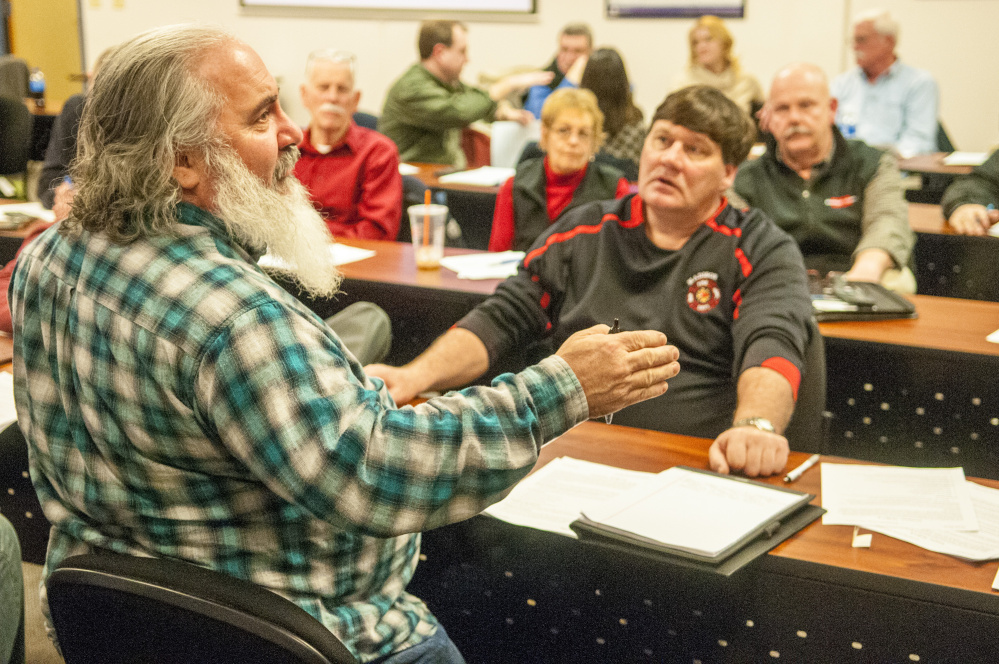The state’s emergency planners are not overly concerned about the possibility that thawing rivers and rainstorms could lead to serious flooding this winter and spring.
But because emergencies can always sneak up on you — as the great flood of the Kennebec River did on central Maine in April 1987 — a group of first responders, emergency planners, dam operators, meteorologists and others from Kennebec, Somerset and Sagadahoc counties got together Thursday in Augusta to consider seriously how they might react if such a disaster were to happen again.
“What caused that flooding was rain, rain and rain,” said Michael Grant, a training coordinator for the Maine Emergency Management Agency, or MEMA. As the Hallowell fire chief in 1987, he said, he had a three-hour period in which to prepare Hallowell’s downtown for the rising water level.
Grant went on to explain how poor the communication was among state, county and local officials following that flood — the type of weather event experts said was statistically likely to happen once every 500 years.
Grant was helping to organize the Thursday exercise at the Central Maine Commerce Center, in which attendees were presented with a series of scenarios related to water levels on the Kennebec River and asked to come up with a coordinated action plan. The exercise was just one way in which emergency planners have tried to prepare better for severe weather-related events like the flood 30 years ago.
In the first scenario, they were told that heavy rain had been falling for the past couple days, saturating the ground, bringing the local waterways to dangerously high levels and prompting the National Weather Service to issue a flood watch.
In the next, they were told it was two days later and that rain had continued to fall, causing minor flooding in areas such as the parking lot on Front Street in Augusta and leading to a flood warning from the National Weather Service.
Attendees discussed each scenario in smaller groups, largely based on the counties they came from, then reported back to the crowd.
After the first scenario, Mike Smith, director of the Somerset County Emergency Management Agency, said that he would have been on the lookout for emergency warnings from dam operators and the National Weather Service, then relayed those notifications to emergency planners and fire chiefs in every municipality.
Smith also said he would consider issuing a reverse 911 call, in which residents are notified of the flood risk via the local public safety communications system. But Smith acknowledged the risk that those steps could falter if local agencies aren’t checking their emails or can’t receive emergency text messages.
“We’re not sure how far down in the weeds we’re going to be,” he said. “There needs to be situational awareness at all levels.”
Other responders pointed to other challenges unique to their organizations and areas.
Sean Goodwin, director of the Kennebec County Emergency Agency, said that the capital area is not well-suited to reverse 911 calls, as there are multiple emergency dispatch centers in the area.
Skowhegan straddles the Kennebec River, so its firefighters would need to make sure both sides were covered during an emergency, said Ty Strout, a full-time member of that department.
Al Nelson, chief of the Gardiner fire and rescue service, said he would have to install ambulance units on both sides of the river. Nelson also said that flooding on Cobbosseecontee Stream could render transportation along Maine Avenue impossible.
“Some of it’s by the seat of your pants,” Nelson said of the improvisation that’s required when responding to serious weather events.
The state has made changes in its emergency protocols since the flood of 1987. One of the biggest is an annual meeting of a special group of experts and emergency planners who forecast the flood risk each spring.
That group, the Maine River Flow Advisory Commission, met earlier in the day Thursday and will be releasing its annual report Friday, said Susan Faloon, MEMA’s spokeswoman.
In a news release about the meeting, MEMA Director Bruce Fitzgerald said the statewide flood risk does not appear to be great this year, in part because of a recent spell of warmer-than-average weather, which has led to melting on the state’s larger waterways.
“It’s mostly encouraging news today,” Fitzgerald said. “There are only a couple of ice jams, which we will be watching closely, but we have no major concerns for flooding.”
The U.S. Coast Guard has begun breaking up ice on the Penobscot and Kennebec rivers, the agency said in its news release, and MEMA officials are monitoring the ice jams on the Carrabassett and Sandy rivers.
During the flood exercise later in the day, MEMA officials said that statewide communication after disasters like the 1987 flood and the 1998 ice storm has improved, both ahead of and during those emergencies.
Those exercises are important, Faloon said, “because you can’t start figuring out what you’re going to do when the water is rising.”
Charles Eichacker — 621-5642
Twitter: @ceichacker
Send questions/comments to the editors.







Success. Please wait for the page to reload. If the page does not reload within 5 seconds, please refresh the page.
Enter your email and password to access comments.
Hi, to comment on stories you must . This profile is in addition to your subscription and website login.
Already have a commenting profile? .
Invalid username/password.
Please check your email to confirm and complete your registration.
Only subscribers are eligible to post comments. Please subscribe or login first for digital access. Here’s why.
Use the form below to reset your password. When you've submitted your account email, we will send an email with a reset code.